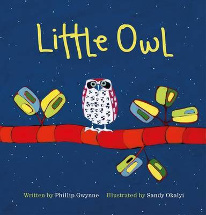Little owl by Phillip Gwynne

Ill. by Sandy Okalyi. Working Title Press, 2014. ISBN 9781921504587.
(Age: Preschool) Recommended. Owls. Animal behaviour. When the
Little Owl falls from his tree, he calls out, Whooo am I? In
searching for his identity he comes across a number of other animals
in the forest, and asks the same thing of each of them, Whoo am I?
The two lines are repeated:
But when he opened his beak, out came a hoot
Whooo? Whooo? Whooo? am I? asked Little Owl.
He asks a sugar glider, eating the same thing that he eats, but the
glider soars away. He asks a bat, but the bat swoops away. He asks a
cockatoo, but the cockatoo struts away, and so on until at the end
his Whooo is answered by his mother and he is restored to the branch
once again.
This is a lovely story of loss, of finding one's place in the world,
of families and relationships, of finding your feet. In telling us
the tale of Little Owl, Gwynne also introduces other Australian
animals to the reader, using words which best describe their
behaviour, a neat introduction to words that describe for younger
readers. The repeated refrain too, encourages younger children to
join in with the known lines as they appear, listening for the new
line inserted each time it is read out, a neat way of surprising
them and expanding their knowledge of the known refrain. By the time
the book has been read several times, I am sure most children, if
not the adult reading it, will know that refrain well.
The illustrations are wonderful, showing the owl and the other
animals in sculptural forms, angular and boldly coloured, lighting
up the pages as each is turned. The tree branches sprout the most
fascinating leaves while many of the animals had me chortling as I
took them in. The layout of the book too is something which helps
the story flow, and small children will love to read of one animal
and how it scarpers away looking eagerly to see which animal
follows. Younger readers are in for a treat when this book is read
to them.
Fran Knight